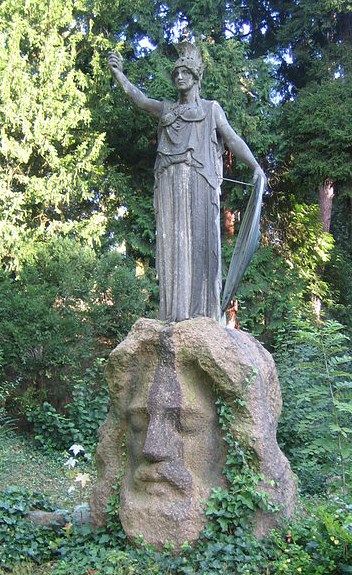(Originally published for Building Bridges Online Magazine, February 2011)
Greetings from the monthly column: Reflections of Her. A little corner to enter into the specific space of a certain face of the Goddess. A place to explore the specific dimension of a certain reflection of the Divine Feminine. May you find your own reflections here as well.
BRIGHID
Culture: Celtic (Irish)
Domain: Healing, Poetry, Smithcraft
Aspect: Triple Goddess
Other Names: Bride, Brigit, Brighide, Brigantia, Briginda, Brigidu
Symbols: White cow (with red ears), snake, sheep, boar, white swan, wells and springs
Though it is difficult to find many myths and stories about Brighid, She is one of the most loved of the Celtic pantheon and was known throughout the ancient world with slight variations to Her name. In fact, the tribe of Brigantes took their name from Her (forgiving them their ghastly contribution to Celtic history through their queen, Cartimandua). It is said that She came to Ireland with two oxen (called Fea and Fermhean), one pig (called Triath) and one huge boar (called Torc Triath) and that these animals would cry out if Ireland was ever under attack or threat. It is also said that She was the daughter of the Dagda, the great God of the Celts (who described as an unkempt and ugly buffoon, and much loved). Some say She was the mother of Ruadhan; others that She was the mother of three Gods of Danu (named either Brian, Iuchar and Iucharba or Goibhnui the smith, Luchta the wright and Credne Cerd the metalworker)
It is important when exploring the myths of Brighid that there are two that have become intertwined. As a Celtic Goddess, She was so loved in Ireland that, with the coming of Christianity, She was transformed into and embraced instead as St. Brigid.
As the Goddess Brighid, She is the “Fiery Arrow” who fans the gifts of fire in many forms. The hearth fire is sacred to Her, as well as the qualities of peace, purification and hospitality it brings. There is also a connection with the healing aspect of the hearth fire. Perhaps in some way connected to the emotional rest one can often find there or connected to the more tangible element of creating healing teas and potions. The ‘fires of inspiration’ are also Her domain, touching on multiple elements as well. Clearly, this is where the poetic domain lies. But it also other significant creative areas important to the Celts, such as smithcraft and metalwork. Each of these speak to Divine inspiration and are metaphors for Divine connection and magical powers. Brighid is also the Goddess of Spring, of abundance and increase. Wells and springs are sacred to Her and the waters that begin to run at this time give healing to those who come to them in Her name. If you see a well that has been decorated with ribbons and flowers, no doubt someone has taken a moment to honour Brigid and receive Her blessing.
St. Brigid was said to have been an abbess around 525 C.E. (around the same time as St. Patrick) and was associated with the town of Kildare. Most famously, the flame of Brigid (which no man could see) was tended by 19 nuns. There was one nun to tend the flame for each of 19 days. On the 20th day, it was said to be tended by Brigid Herself. Doused by King Henry VIII (in the 16th century), it was relit in 1992 by Brigantine nuns in Kildare. Called “Selas Bhride” (“Light of Brigit”), this light still burns today in a house of nuns in a modest suburb of Kildare.
There are many traditions associated with Brighid and ways in which to honour Her today. Most carry Her name.
Perhaps the most familiar is that of the “Crosog Brigde” or Brigit’s Cross. These are 3 or 4 pronged crosses created out of rushes that were hung in homes and barns for protection. This symbol is still well-known in connection with the Goddess.
An extension of Brigit’s Cross is the less well-known “Crios Bride” or Brigit’s Girdle. These were large hoops of wheat, straw or rope that had 4 Brigit’s Crosses attached at various points. Traditionally, everyone in the family or community would step through the hoop three times, reciting “Brigit’s Girdle is my girdle, the girdle with the four crosses. Rise, housewife and go out three times. May whoever goes through my girdle be seven times better a year from now.”
The “Brideog” is a doll usually created from an ear of corn from the previous harvest, decorated to represent Brighid. In some communities, children would carry Brideog from house to house and ask for treats, offering Brighid’s blessing in return.
In some communities, while the younger girls made the Brideog, the older women would make the Leaba Bride or “Bride’s Bed”. On the Eve of the Festival of Brigit (which falls on February 1), the girls would bring the Brideog into the house to lay in the bed. For some, a wand of birch, broom, bramble or white willow was placed in the bed alongside the Brideog to represent the qualities of justice and peace and her divine lover, Oenghus. The following would be said three times: “Let Bride come in. Bride is welcome. Bride, come in. Your bed is made.” On the morning of February 1, the ashes of the hearth fire would be scanned to see if the wand had made an imprint. Called “Brigit’s footprint”, this was considered a very good sign and the household especially blessed.
Even one who is not particularly craft-handy can participate in the common tradition of the “Brat Bride” or Brigit’s Mantle. This is a piece of cloth or ribbon left outside to receive Brighid’s blessing as She passes on the Eve of Her feast day. More connected with the saint than the Goddess, this tradition in inspired by the story that Brigid was midwife to Mary at the birth of Jesus, wrapping the wondrous child in her cloak. Traditionally, if the Brat Bride has collected dew in the night, it is considered blessed and the cloth itself said to be imbued with healing powers.
Clearly, with so many traditions to honour Her, Brighid was and is well-loved. Her energy is integral to welcoming the warmer elements of Spring. The joy expressed in honouring Her at Imbolc is, in part, the relief felt at knowing the worst of the Winter is over. It is saying good-bye to the “Hag of Winter” as we embrace the “Maiden of Spring”. Nowadays, we look to the groundhog to tell us how close to saying good-bye we are. But originally, this tradition was connected with Brighid, albeit with a difference. It is said that on Imbolc morn, a snake would awake from its Winter sleep and emerge from its hole. Upon seeing the snake, it is traditional to recite this charm: “Early on Bride’s morn the serpent shall come from its hole. I will not molest the serpent nor will the serpent molest me”. There are interesting depths to this particular tradition, in that there are no indigenous snakes in Ireland! It seems an odd tradition to attribute to a predominantly Irish Goddess. Some explain by saying it is rooted in Scottish lore. But on some levels, it also seems to be a response tradition to the tale of the other 5th century Irish Saint: Patrick, who is said to have “driven snakes from Ireland”. It warrants noting that there is an air of acceptance and mutual respect in Brighid’s tradition that is lacking in St. Patrick’s story.
Without doubt, Brighid is a fascinating Goddess whose stories, myths and traditions deserve far more than a passing article. She touches on hearth and home, on poetry and inspiration, on the powers of healing, the powers of communication, the powers of creativity. She is the protector of beginnings (a midwife to life) and ushers in the hope and energy of budding life (the burst of Spring).
One of the beautiful traditions connected with Candlemas is that of candle-making. That this was the time of year to make the candles that would last throughout the year. There is a sense of purification which comes from creating anew that which will provide light throughout the year. And what a beautiful way to connect to the energies of Brigid: in the making and in the lighting. Bringing the light of inspiration and healing into our own lives.

